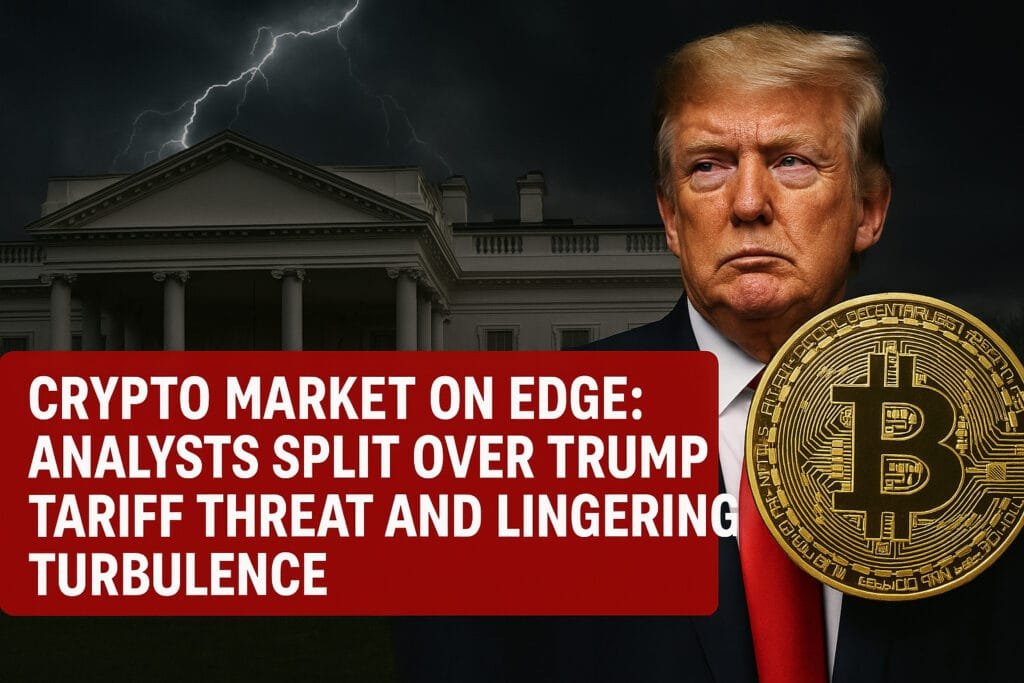Crypto Market on Edge: Analysts Split Over Trump Tariff Probability and Lingering Turbulence

Crypto Market on Edge: Analysts Split Over Trump Tariff Probability and Lingering Turbulence
The contemporary landscape of the cryptocurrency market is in a state of flux, teetering on the precipice of uncertainty as analysts fervently debate the implications of potential tariffs imposed by the Trump administration. This comprehensive analysis dives deep into the heart of the matter, unraveling the complexities of the crypto market, examining how political decisions could reverberate within this high-stakes financial environment, and offering a unique perspective on the ramifications of these tariffs.
The Current State of the Crypto Market
The crypto market has always been synonymous with volatility, but recent events have further intensified this characteristic. With Bitcoin alternatives rising and regulatory uncertainties looming, traders and investors find themselves in a precarious position. As of late, Bitcoin has been fluctuating around the $30,000 mark, stirring a sense of caution among market participants.
Key drivers of this market turbulence include:
- Geopolitical tensions – International relations continue to shape economic expectations, leading to fluctuations in asset prices.
- Regulatory uncertainty – The ambiguity surrounding cryptocurrency regulations keeps investors on edge, delaying long-term decision-making.
- Market speculation – Social media narratives and speculation can dramatically influence cryptocurrency values overnight.
The Trump Tariff Dilemma
President Trump’s tariff policies have been a point of controversial debate, encapsulating a spectrum of opinions among economists and financial analysts. The uncertainty pertaining to new tariffs has created an unpredictably volatile environment for cryptocurrencies, with analysts split on their potential impact:
Potential Outcomes of Tariff Impositions
Analysts foresee various consequences stemming from the reimplementation of tariffs, emphasizing the following possibilities:
- Devaluation of fiat currencies – Tariffs could lead to a decline in the value of the U.S. dollar, making cryptocurrencies more appealing as a hedge against inflation.
- Impact on mining operations – Increased tariffs on imported mining equipment may affect operational costs, leading to reduced profitability for miners.
- Shifts in market sentiment – Investor confidence could wane, leading to increased volatility as traders react to changing conditions.
Market Reactions: What Analysts Are Saying
The crypto market’s reaction to tariff chatter has been distinctly mixed. Some analysts advocate that tariffs could bolster interest in cryptocurrencies, while others warn of potential downturns. Key insights include:
Positive Sentiment from Some Analysts
- Increased Demand for Decentralization – Cryptocurrencies offer a level of decentralization that may appeal to investors wary of traditional currencies undermined by tariffs.
- Potential for Increased Investor Interest – As tariffs create economic uncertainty, some investors might shift their focus towards crypto as a more stable asset.
Concerns from Cautious Analysts
- Market Volatility – The speculative nature of cryptocurrencies often results in swift price changes, where fear can lead to panic selling.
- Regulatory Backlash – Heightened scrutiny from governments may arise as the crypto market grows, generating stricter regulations.
Diving Deeper: Understanding Tariff Mechanisms
To grasp the nuances of how tariffs can impact the crypto market, it’s essential to understand the mechanisms at play:
- Import Duties: Tariffs are taxes levied on imported goods. A rise in import duties can theoretically increase costs for mining rigs and other necessary equipment, directly affecting profitability.
- Trade Relations: Tariffs influence global trade relations, making cross-border transactions more expensive. This could have implications for blockchain technology development and cryptocurrency exchange operations.
The Broader Implications for Blockchain Technology
The potential for tariffs to impact cryptocurrencies extends beyond mere market prices. They can also shape the developments of blockchain technologies as a whole:
- Innovation Trends – Tariffs might drive companies to innovate more around blockchain solutions that reduce reliance on traditional financial structures negatively impacted by such policies.
- Investment Redirection – Capital could shift towards decentralized finance (DeFi) projects as businesses adapt to circumvent potential tariff impacts.
Looking Ahead: Future Predictions and Markets’ Response
The interplay between tariffs and the cryptocurrency market paints a complex picture that evolves in real time. Moving forward, several predictions arise:
- Increased Regulation – As cryptocurrencies become more mainstream, regulators may respond by instituting stricter guidelines, influenced by tariff outcomes.
- Resilience of Cryptocurrency – Historical trends suggest that despite short-term disruptions, cryptocurrencies tend to recover and sometimes thrive under adverse economic conditions.
Expert Insights: The Importance of Being Prepared
As the situation unfolds, analysts encourage investors to remain vigilant and prepared. Here are some actionable insights for navigating this turbulent terrain:
- Diversify Your Portfolio – Consider diversifying investments across various cryptocurrencies to mitigate risks associated with volatile market fluctuations.
- Stay Informed – Following reliable news sources and market analyses can keep investors ahead of the curve in this fast-paced industry. Websites like BizTechLive offer a wealth of information to help make informed decisions.
Conclusion
The intertwining of tariff discussions and the cryptocurrency market presents a unique blend of challenges and opportunities. As analysts continue to diverge in their perspectives, one thing is clear: the need for adaptability and informed decision-making has never been more critical. By paying close attention to the political landscape and its potential implications for the crypto market, investors can position themselves to capitalize on future growth while mitigating risks.
For further insights and developments in the cryptocurrency landscape, explore related articles on our website like Crypto Analysis and Trends and stay abreast of the ever-evolving market dynamics that impact investments.
Additionally, for comprehensive updates, check precedent data at external resources such as CoinDesk and Forbes Crypto & Blockchain.








